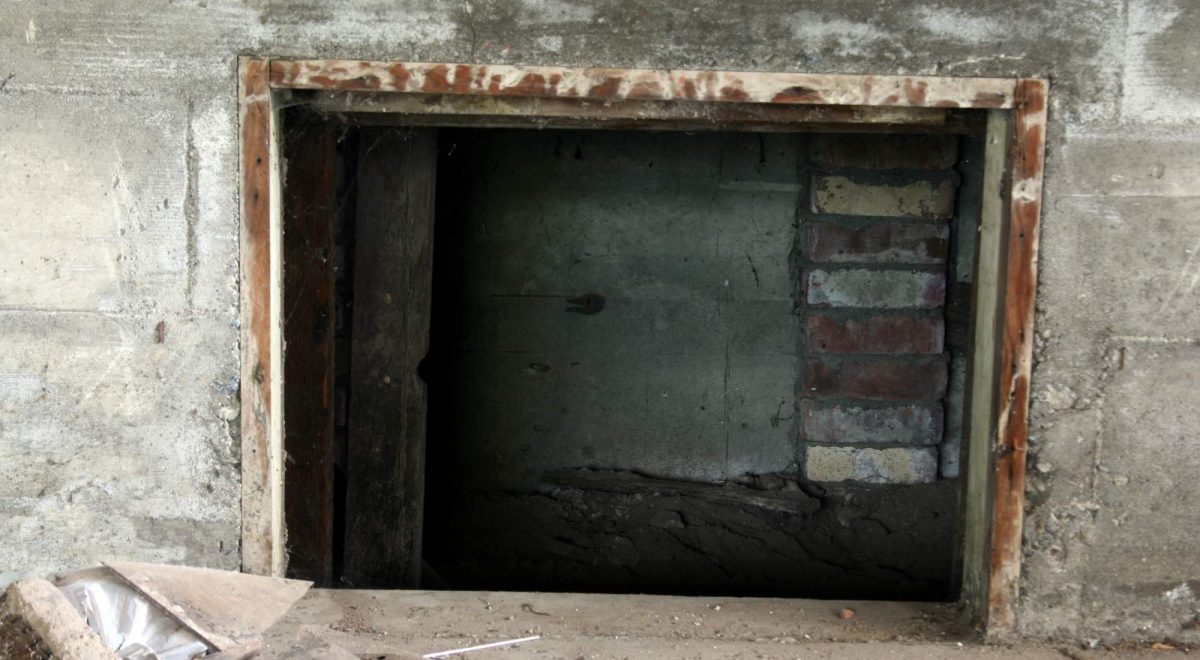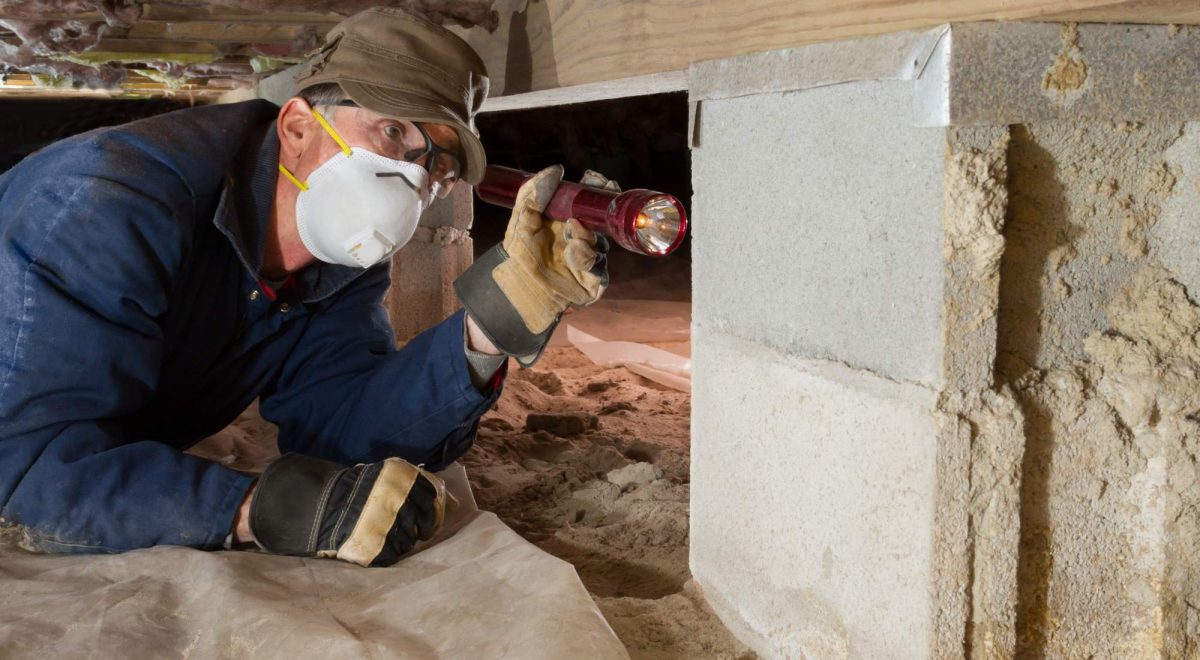If you’re like most people who have a crawl space in their home, you don’t go in there very often. But the last time you peeked inside, you noticed a few puddles and were wondering if it was a cause for concern.
The answer is yes. Standing water in a crawl space can cause a host of issues such as …
- Structural
- Cosmetic; and
- Health
… damage.
Keep reading to find out the main causes of water in a crawl space and what you can do if you find it there.
Table of Contents
- Is Water in a Crawl Space Normal?
- Why Is There Water in My Crawl Space?
- What Should I Do if I Have Running or Standing Water in my Crawl Space? Start By Identifying the Source
- The Top 4 Causes of Water in a Crawl Space
- 4 Negative Effects of Water in a Crawl Space & Why It’s Important to Get It Looked at ASAP
- Finding Water in Your Crawl Space? Don’t Risk the Integrity of Your Home or Your Health — Contact the Professionals at Pure Environmental Today

Is Water in a Crawl Space Normal?
Water in your home’s crawl space is not normal and should not be there.
If you see water in your crawl space — even if it’s only a small amount — it is imperative that you figure out the issue.
Standing water in a crawl space isn’t just a mild annoyance. It can have devastating effects on your home’s value by creating structural problems and health hazards.
Water in a crawl space won’t go away on its own, so the first thing you need to do is get to the bottom of things and find out why it is there.
Why Is There Water in My Crawl Space?
There can be many explanations for what causes standing water in a crawl space.
Some are obvious. If you live in an area prone to flooding, you are likely to frequently end up with a wet crawl space.
Others are harder to track down, such as a crack in your foundation.
No matter how the water got there in the first place, it should be dealt with as soon as possible.
What Should I Do if I Have Running or Standing Water in My Crawl Space? Start By Identifying the Source
How you deal with water in your crawl space can vary greatly depending on what the cause is — so that’s where you need to start.
The most common reasons for crawl space water issues usually fall into one of two categories:
1. Water from outside coming into the structure
or
2. Water in the crawl space due to a problem with the structure
Depending on the underlying issue, your solution may be as simple as cleaning out your gutters and drying your crawl space with a shop vac and fans.
Or you may have a huge, weeks-long project to deal with, such as lifting your house to repair the foundation.
Since pinpointing the source of water in a crawl space is vital, you should consider having experts like the team at Pure Environmental come do an inspection for you. They will find the problem causing your moisture issue and recommend the correct path for remediation.

The Top 4 Causes of Water in a Crawl Space
#1: Improper Grading
Grading is important as it directs runoff from stormwater away from the foundation of your home. If it wasn’t done right when the home was built, surface water can be trapped up against the foundation.
The best defense against water saturation is grading the site so that it slopes away from the foundation and water drains away from the house on all sides.
Improper grading can lead to water entering your crawl space from:
- Heavy rainfall
- Flash floods
- Storm debris clogging your vents and leading to moisture buildup
If you find that you have constant standing water in your yard that threatens to encroach on your crawl space, you should take action to fix the problem.
The good news is that negative grading repair doesn’t have to be a big, costly project. Solutions for this issue might be:
- Shoveling soil toward your house
- Changing your landscaping to direct the flow of water away from your home
- Replanting grass
- Having a drainage pipe installed
#2: Clogged Gutters Leaking Into Your Crawl Space
When was the last time you cleaned the gutters or downspouts of your house? These items are meant to direct water away from your home, but they can become clogged with things like:
- Leaves
- Acorns
- Pine cones
- Twigs
- Bird nests
- And more
This prevents gutters and downspouts from being able to move water effectively, which can lead to buildup next to the crawl space and a danger of moisture seeping inside.
The solution to this one is pretty simple — keep those puppies cleaned out! If you don’t want to do it yourself, hire someone else to do the job for you. Just make sure to clean them regularly if you live in an area with lots of debris.
#3: Cracks in Your Foundation
As a house ages, it undergoes settling. This just means that, over time, the home begins to gradually sink further into the ground because of a shift in the soil beneath its foundation.
Settling may not cause any problems with your house, or it can lead to cracks or gaps in the foundation. This makes it harder for the foundation to withstand water and can lead to moisture seeping into the crawl space.
If it seems that your crawl space water issues are due to problems with the foundation, you should call a repair expert or structural engineer as soon as possible to come up with a plan to fix it.
#4: Water Line Malfunctions
There is an enormous amount of water flowing in and out of your home at all times. Water pipes bring in water from a source, and sewer lines take it back out again.
If anything goes wrong with these — such as a broken pipe or a clog in the line — your home can be flooded with water.
If this happens, you’ll want to turn off your water immediately and contact a plumber to repair the pipe or clear the clog.
4 Negative Effects of Water in a Crawl Space & Why It’s Important to Get It Looked at ASAP
We’ve talked about how to repair some of the issues that cause standing water in a crawl space, but you can’t stop there.
The repair and restoration of your crawl space — by a company such as Pure Environmental — after it has suffered water damage is essential. Otherwise, it can lead to a host of negative consequences that may cost you greatly in the long run.
#1: Mildew and Mold Growth
A wet crawl space can cause mold, mildew, and fungus to grow in your home. This can be dangerous to your health as it may lead to respiratory problems.
If you are allergic to mold, exposure to it can trigger reactions and asthma symptoms. But even if mold isn’t present, the dampness alone can cause asthma attacks and other respiratory issues.
And even if you aren’t allergic, just being around dampness and mold for extended periods can lead to:
- Irritation of the eyes, skin, nose, throat, and lungs
- Coughing
- Wheezing
- Nasal congestion
- Sore throat
- Sneezing
- Runny nose
- Headaches
Untreated symptoms from exposure to mold and mildew can cause severe infections and have even been known to lead to death. Assuming your crawl space will dry out on its own is not a risk you want to take when it comes to the health of you and your family.
You can often identify the presence of mold in your home by its musty, stale, and earthy smell.
You will also be able to see some mold, mildew, and fungus growing on surfaces in your home, especially close to the water source in the crawl space. However, mold isn’t always visible.
In any scenario where you find sitting water, it’s essential to have an expert inspect your home and test for mold.
#2: Increased Risk for Pest Infestations
Many pests are attracted to warm, moist environments. So if there is water in your crawl space, it could become a haven for ants, rats, mites, dust mites, and more.
Ants are not only a nuisance, but they can cause damage to your home. Here are several species of ants that are common in the Northwest:
- Odorous House Ants
- Carpenter Ants
- Moisture Ant (quite aptly named!)
Rats and mice can be dangerous since they are known to carry diseases such as …
- Leptospirosis
- Hantavirus; and
- Lymphocytic choriomeningitis
… which can lead to death.
Dust mites also thrive in high humidity. They can make their way into:
- Fabric
- Carpet
- Beds
- Furniture; and
- Clothing
The presence of dust mites is also known to cause respiratory issues.
Unchecked moisture can also attract termites, which we’ll discuss more below.
#3: Structural Damage
The continuous presence of water in a crawl space can lead to:
- Wood rot
- Hardwood floor cupping; and
- Termite damage
Since termites are attracted to decaying wood, leaving a wet space untreated only makes a bad situation worse. What started as some rotting wood in your lower level could lead to termite damage throughout your entire home.
#4: Higher Utility Bills
Water in your crawl space leads to higher humidity levels due to the damp air.
Since damp air is harder to heat and cool, your HVAC system will have to work overtime to keep your home comfortable, which will cause higher gas and/or electricity bills.
Better to invest a little money up front to have a reputable company treat and repair your crawl space to rid your home of high humidity.

Finding Water in Your Crawl Space? Don’t Risk the Integrity of Your Home or Your Health — Contact the Professionals at Pure Environmental Today
Pure Environmental is committed to providing top-notch services for indoor air quality restoration. If your home is suffering from issues like mold and odors due to water in your crawl space, we can help. Don’t risk the health of your family and the safety of your home environment by ignoring the issues that crawl space water issues can cause.
Contact us today for a free estimate and learn how we can assist you.
Recent posts
- Pros and Cons of Heat Treatment for Bed Bugs: Things To Consider When Reviewing Your Options for Remediation
- How To Get Rid of Pet Odor in Your House
- Clearing the Air: How To Clean Walls From Cigarette Smoke
- Deodorizing Your Living Space: How To Get Rid of a Musty Smell in Your House
- How Do You Get Rid of Mold in Your Attic? Tips from the Professionals
Recent Posts
- Pros and Cons of Heat Treatment for Bed Bugs: Things To Consider When Reviewing Your Options for Remediation
- How To Get Rid of Pet Odor in Your House
- Clearing the Air: How To Clean Walls From Cigarette Smoke
- Deodorizing Your Living Space: How To Get Rid of a Musty Smell in Your House
- How Do You Get Rid of Mold in Your Attic? Tips from the Professionals
